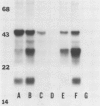Abstract
Swiss Webster mice were infected with either the relatively virulent C56 strain or the relatively avirulent C37 strain of Toxoplasma gondii, and the sequence of their antibody response to surface antigens of the parasite was studied. An immunoglobulin M (IgM) agglutinating antibody was the first serologically detectable antibody and was first detected on day 2 in mice infected with the C37 strain and on day 5 in mice infected with the C56 strain. IgG antibodies were first detected on day 8 for both strains. The major component of the IgG antibodies was IgG2:IgG3 antibodies had lower titers, and no IgG1 antibodies were detected. The IgG antibodies were active in direct parasite agglutination and in the complement-dependent cytotoxicity assay of Sabin and Feldman (Science 108:660-663, 1948). On sodium dodecyl sulfate-polyacrylamide gel electrophoresis, sera from mice infected with T. gondii detected all major radioiodinated surface proteins of toxoplasma tachyzoites. The earliest time point at which these antigens were detected differed for the two strains. Serum from mice infected with C56 strain immunoprecipitated all cell surface antigens by day 10 of infection, whereas serum from mice infected with the C37 strain did not do so until day 15 of infection.
Full text
PDF





Images in this article
Selected References
These references are in PubMed. This may not be the complete list of references from this article.
- Anderson S. E., Bautista S., Remington J. S. Induction of resistance to Toxoplasma gondii in human macrophages by soluble lymphocyte products. J Immunol. 1976 Aug;117(2):381–387. [PubMed] [Google Scholar]
- Bloomfield M. M., Remington J. S. Comparison of three strains of Toxoplasma gondii by polyacrylamide-gel electrophoresis. Trop Geogr Med. 1970 Sep;22(3):367–370. [PubMed] [Google Scholar]
- Desmonts G., Baufine-Ducrocq H., Couzineau P., Peloux Y. Anticorps toxoplasmiques naturels. Nouv Presse Med. 1974 Jun 15;3(24):1547–1549. [PubMed] [Google Scholar]
- Desmonts G., Remington J. S. Direct agglutination test for diagnosis of Toxoplasma infection: method for increasing sensitivity and specificity. J Clin Microbiol. 1980 Jun;11(6):562–568. doi: 10.1128/jcm.11.6.562-568.1980. [DOI] [PMC free article] [PubMed] [Google Scholar]
- Feldman J. D. Immunological enhancement: a study of blocking antibodies. Adv Immunol. 1972;15:167–214. doi: 10.1016/s0065-2776(08)60685-9. [DOI] [PubMed] [Google Scholar]
- Goding J. W. Conjugation of antibodies with fluorochromes: modifications to the standard methods. J Immunol Methods. 1976;13(3-4):215–226. doi: 10.1016/0022-1759(76)90068-5. [DOI] [PubMed] [Google Scholar]
- Jones P. P. Analysis of H-2 and Ia molecules by two-dimensional gel electrophoresis. J Exp Med. 1977 Nov 1;146(5):1261–1279. doi: 10.1084/jem.146.5.1261. [DOI] [PMC free article] [PubMed] [Google Scholar]
- Jones T. C., Len L., Hirsch J. G. Assessment in vitro of immunity against Toxoplasma gondii. J Exp Med. 1975 Feb 1;141(2):466–482. doi: 10.1084/jem.141.2.466. [DOI] [PMC free article] [PubMed] [Google Scholar]
- Kessler S. W. Rapid isolation of antigens from cells with a staphylococcal protein A-antibody adsorbent: parameters of the interaction of antibody-antigen complexes with protein A. J Immunol. 1975 Dec;115(6):1617–1624. [PubMed] [Google Scholar]
- Laemmli U. K. Cleavage of structural proteins during the assembly of the head of bacteriophage T4. Nature. 1970 Aug 15;227(5259):680–685. doi: 10.1038/227680a0. [DOI] [PubMed] [Google Scholar]
- Laskey R. A., Mills A. D. Enhanced autoradiographic detection of 32P and 125I using intensifying screens and hypersensitized film. FEBS Lett. 1977 Oct 15;82(2):314–316. doi: 10.1016/0014-5793(77)80609-1. [DOI] [PubMed] [Google Scholar]
- Marchalonis J. J., Cone R. E., Santer V. Enzymic iodination. A probe for accessible surface proteins of normal and neoplastic lymphocytes. Biochem J. 1971 Oct;124(5):921–927. doi: 10.1042/bj1240921. [DOI] [PMC free article] [PubMed] [Google Scholar]
- O'Farrell P. Z., Goodman H. M., O'Farrell P. H. High resolution two-dimensional electrophoresis of basic as well as acidic proteins. Cell. 1977 Dec;12(4):1133–1141. doi: 10.1016/0092-8674(77)90176-3. [DOI] [PubMed] [Google Scholar]
- Parks D. R., Bryan V. M., Oi V. T., Herzenberg L. A. Antigen-specific identification and cloning of hybridomas with a fluorescence-activated cell sorter. Proc Natl Acad Sci U S A. 1979 Apr;76(4):1962–1966. doi: 10.1073/pnas.76.4.1962. [DOI] [PMC free article] [PubMed] [Google Scholar]
- Perlmutter R. M., Hansburg D., Briles D. E., Nicolotti R. A., Davie J. M. Subclass restriction of murine anti-carbohydrate antibodies. J Immunol. 1978 Aug;121(2):566–572. [PubMed] [Google Scholar]
- Sabin A. B., Feldman H. A. Dyes as Microchemical Indicators of a New Immunity Phenomenon Affecting a Protozoon Parasite (Toxoplasma). Science. 1948 Dec 10;108(2815):660–663. doi: 10.1126/science.108.2815.660. [DOI] [PubMed] [Google Scholar]
- Seed J. R. Trypanosoma gambiense and T. equiperdum: characterization of variant specific antigens. Exp Parasitol. 1972 Feb;31(1):98–108. doi: 10.1016/0014-4894(72)90052-5. [DOI] [PubMed] [Google Scholar]
- Spiegelberg H. L. Biological activities of immunoglobulins of different classes and subclasses. Adv Immunol. 1974;19(0):259–294. doi: 10.1016/s0065-2776(08)60254-0. [DOI] [PubMed] [Google Scholar]
- Walton B. C., Benchoff B. M., Brooks W. H. Comparison of the indirect fluorescent antibody test and methylene blue dye test for detection of antibodies to Toxoplasma gondii. Am J Trop Med Hyg. 1966 Mar;15(2):149–152. doi: 10.4269/ajtmh.1966.15.149. [DOI] [PubMed] [Google Scholar]




